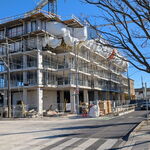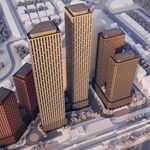LRT supporter Gord Perks should have been weary with defeat.
But at a moment when reasonable people were declaring the death of LRT in Toronto, the city councillor sounded anything but crushed on Wednesday.
Less than 24 hours earlier, Perks was on the losing side of a 24-20 council vote that killed a fully-funded, seven-stop LRT in favour of a twice-as-costly, three-stop subway in Scarborough that is likely to put Toronto in debt for 30 years.
Subway campaigner Mayor Rob Ford crowed that plans for LRTs on Sheppard Ave. East and Finch Ave. West are next on his hit list.
But Perks points to the narrow subway win as proof that LRT is gaining ground in Toronto. The subway decision, he says is “the last gasp of the Toronto myth that subway is the only good form of transit.”
Doug Ford at Ford Fest in Centennial ParkDoug Ford at Ford Fest in Centennial Park
Juice throwing charges droppedJuice throwing charges dropped “We’re going to have light rail and we’re going to have it soon . . . We simply cannot cover the vast size of the amalgamated city with subways. It’s not technically or economically possible to do that,” said Perks.
The Eglinton-Scarborough Crosstown LRT, already under construction, will let transit-hungry, cash-poor Torontonians taste the technology that cities across North America and Europe are clamouring to build — and they will want it too, he insists.
Other LRT supporters are less optimistic.
“I don’t think (LRT) is dead. But it’s certainly on life support,” says transit blogger Steve Munro.
If Mayor Rob Ford and the Ontario Liberals both win elections next year, he fears for the Sheppard and Finch LRTs. Munro isn’t even confident that the city or province won’t try and convert Eglinton Ave. — which will run about 10 kilometres in a tunnel — to a subway.
“I worry that at some point the (Eglinton) technology choice will be changed, which will require a redesign and greater expanse of the (tunneled) section east of Leaside, as well as pretty much deep-sixing forever the extension west to the airport because there’s no way we’re going to build a subway all the way to the airport,” he said.
During months of debate about which kind of transit should replace the Scarborough RT, transit officials and politicians did a poor job of communicating the differences between the lumbering downtown streetcars and the light rail technology being planned for the suburbs, adds Munro.
Not only do the LRTs run in their own lanes, outside of traffic on wide streets, they are faster. By way of comparison, he offers the mayor’s favourite target of derision, the St. Clair Ave. streetcar.
Between Keele and Bathurst Sts., there are 20 streetcar stops on St. Clair. If St. Clair used LRT stop spacing, there would be six.
One justification used to favour a subway in Scarborough was that it would eliminate a transfer between the originally planned Scarborough LRT and the Bloor-Danforth subway platform. Subway proponents argued that commuters wouldn’t like it, they wanted a one-seat ride.
How big a deal was the transfer? On Thursday, Metrolinx told the Toronto Star it was estimated to take 40 seconds, plus the time a rider might wait for the subway to arrive.
But one powerful argument in favour of LRT wasn’t discussed in the Scarborough debate because it simply didn’t apply. That LRT was never going to run in traffic on a street.
So LRT’s potential to bring new life to deadened streets has been largely overlooked in recent transit technology debates.
“I’m holding out hope that the Sheppard and Finch lines are really going to show what above-ground rapid transit can do to revitalize parts of the city,” said Cherise Burda of the Pembina Institute, a sustainability think tank.
It’s not viable for everyone to go to Denver where an LRT — paid for in part by a sales tax increase — is part of “an incredible downtown revitalization,” she said.
But Torontonians could look north of Steeles Ave. at York Region where new lane-separated bus rapid transit will operate very much like an LRT until transit ridership justifies laying tracks on the roads.
“It’s just LRT without the rails. It’s all about right-of-way,” says Burda, who says Torontonians have trouble imagining transit operating away from cars on the street.
As for the cost of subways, don’t even get her started.
A member of the Anne Golden panel appointed by Premier Kathleen Wynne to look at raising taxes for transit expansion, Burda worries that the council-approved 1.6 per cent property tax levy to pay for the Scarborough subway means the city is tapped out.
How will it contribute to the provincial transit investment strategy that is supposed to pay for the badly needed downtown relief subway?
But the lack of transit funding could be the salvation of LRT on Sheppard and Finch, she said.
“What are we expecting to do — to triple the cost on each of those lines? Go to the federal government and raise property taxes again and again?”




